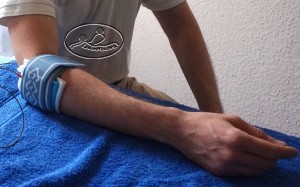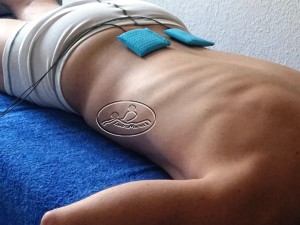Service withdrawn from the offer – sorry.
Electrotherapy uses electric energy (direct current and alternating with different frequencies) for diagnostic, therapeutic and cosmetic. The biological effect of the electrical current causes local and general reaction, and depending on the cause:
• Stimulation of nerves and muscles,
• Relieves pain,
• Alleviation of inflammation,
• Increased tissue perfusion,
• Improving the nutrition of tissues,
• Accelerate metabolism,
• Stimulation of tissue regeneration.
General contraindications for electrotherapy:
• Cancer (during treatment and a history),
• Implanted pacemaker, insulin pump and various types of pacemakers, implants and electrical appliances and others,
• Surroundings of infusion pumps and wenflonami,
• Metals in the tissues undergoing treatment, prosthesis,
• Paralysis spastic and local sensory disturbances,
• Skin lesions (rashes, ulcers, wounds, purulent inflammation, and others),
• United feverish, inflammatory processes and general infections.
• Haemorrhagic diathesis, bleeding, menstruation,
• Intolerance of individual electrotherapy,
• Blood clots, the risk of embolism, thrombophlebitis,
• Atherosclerosis arterial occlusive during IIb-IV according to Fontaine,
• Surroundings abdomen, groin and groin in pregnant women,
• People with impaired contact (unconscious patients with aphasia after head injury, children),
• After surgery on the muscles that spasm could nullify the effects of treatment,
• Eyeballs and the front surface of the neck and scar tissue.
The offer cabinet are electrical currents of low frequency (1-0 kHz) and currents of medium frequency (1-100 KHz):
1. Galvanisation (galvanic current – direct current low frequency).
Indications:
• neuralgia,
• chronic inflammation of the nerves, plexuses and nerve roots,
• pains in osteoarthritis,
• flaccid paralysis,
• difficult bone union,
• peripheral circulatory disorders (increased blood flow),
• swelling,
• slow-healing wounds.
Contraindications: general contraindications as electrotherapy.
Duration 10-20 minutes.

2. Iontophoresis (current low frequency). In iontophoresis procedure is most often used galvanic current to enter the body through the skin of appropriate medication. For this purpose the various types of compounds undergoing electrolytic dissociation (acids, bases, salts). These are drugs in the form of solutions of various compounds of the gels containing the active substances or mineral water.
Indications for surgery as galvanization and also:
• contracture;
• scars,
• frostbite,
• trophic ulcers.
• post-traumatic joints and muscles,
• inflammation of periarticular,
• inflammation of the soft tissues and myalgia,
• sports injuries, overloading joints and tendons.
Contraindications: general contraindications as electrotherapy and also:
• allergic to a particular drug,
• pregnancy.
Duration 10-20 minutes.

3. Electrical stimulation (pulse current of low frequency): The purpose of this therapy is to provoke muscle contraction – muscle exercises, used in muscle rehabilitation is not diseased by spasticity, a muscle atrophy simple. Electrical stimulation is also used in cosmetic treatments.
Indications:
• increase muscle strength and improve the other characteristics of motor muscles,
• stimulation of denervated or transplanted muscle,
• preventing muscle atrophy,
• pain relief,
• improving blood circulation growing cells.
Contraindications: general contraindications as electrotherapy.
Duration of the treatment for 5 minutes or 1-3 sets of 5-20 muscle contractions.
3a. Electrodiagnostics (direct current and alternating low-frequency): The aim is to explore the excitability of nerves and muscles in order to determine the parameters for electrostimulation.
Contraindications: general contraindications as electrotherapy.
4. Diadynamic (direct current and alternating low-frequency): These are currents that have the properties of stimulus currents of variable frequency and analgesic properties, and vasomotor stimulant of muscular DC low frequency. Through a combination of two frequencies and modulation amplitude arises 6 basic types of diadynamic currents (MF, DF, CP, LP, RS, MM).
They used a combination of diadynamic currents, and their main characteristics:
DF, CP, LP – analgesic,
DF, MF, CP – operation congestion and nutrients,
DF, CP, LP – reduces muscle tension,
RS, MM – stimulates muscles in the disappearance of a straight or a slight paresis.
Contraindications: general contraindications as electrotherapy.
Duration to 12 minutes.

5. Trabert current / current ultra stimulus (DC-less component and a variable low frequency): This type of electrotherapy has a strong analgesic effect. It causes muscle tremors and vibrations causing muscle relaxation. This helps to increase the analgesic effect.
Indications:
• neuralgia and myalgia.
• degenerative arthritis
• changes after injuries of muscles and joints,
• constipation,
• peripheral circulatory disorders.
Contraindications: general contraindications as electrotherapy.
Duration of treatment 8 – 15 minutes.
6. Electroacupuncture (AC low frequency): The procedure is performed using the electrode point. Stimulating determined points of the body, activated in the body:
• relieving acute infections and reduce chronic pain and posttraumatic,
• fight obesity and addictions,
• reduce stress and depression, and strengthen immunity.
• fight not by healing the wounds, wrinkles, scars and muscle tension.
• helping to fight with other disabilities.
Contraindications: general contraindications as electrotherapy.
Duration of the treatment to 20 minutes.

7. Tonolisis (AC low frequency) is a muscle electrostimulation affected by spasticity. The treatment involves stimulating muscles stretched at the moment eliminated spastic muscle.
Contraindications: general contraindications as electrotherapy.
Duration of the treatment to 20 minutes.
8. TENS (low frequency alternating current): This is a transcutaneous electrical nerve stimulation. It is a procedure used for the symptomatic treatment of acute and chronic pain syndromes. There are 3 main variations of this method: TENS Conventional, TENS APL – acupuncture, TENS Hipersytmulacja.
Indications that TENS is a chronic and acute pain syndromes resulting from various causes:
• postoperative and post-traumatic,
• rheumatic diseases,
• Internal Medicine,
• neurological diseases,
• orthopedic diseases,
• gynecological diseases,
• migraine,
• toothache and others.
Contraindications: general contraindications as electrotherapy.
Duration of the treatment 20 minutes.
9. Currents Nemec / interference currents (medium frequency alternating current): These are interference currents, or arising from the overlap of two or more waves, leading to the strengthening of the resultant wave. The procedure can be performed using the static interference field (static method), or dynamic (kinetic method consisting in the change in the duration of the procedure arrangement of electrodes). Depending on the used frequency is achieved other therapeutic effects.
Indications for treatment with these currents, relate mainly to various types of muscle dysfunction (eg. Muscle atrophy, muscle dysfunction, reduced muscle innervation and others). This therapy is also used in soft tissue rheumatism, peripheral neuropathies, and in the initial period peripheral circulatory disorders.
Contraindications: general contraindications as electrotherapy and:
• inflammation of the arteries and veins,
• tendency to clot,
• varicose veins,
• acute inflammation of the abdomen,
• multiple sclerosis,
• pain of unclear etiology,
• Parkinson’s disease,
• pregnancy,
• gynecological bleeding,
• myasthenia gravis.
Duration 5-20 minutes.
10. Currents Kotz / Russian stimulation (medium frequency alternating current) treatment of these currents is done to stimulate muscle atrophy simple and as muscular training in athletes to increase muscle size and strength, and procedures modeling figure.
Contraindications: general contraindications as electrotherapy and:
• Fresh torn muscles and tendons,
• disorders of neuromuscular.
Duration 10-20 minutes.
11. Combination therapy (combined). Electrotherapy (TENS, low-frequency currents, currents Nemec) can be combined in a single treatment with other methods of physical attributes, eg. With ultrasound, laser therapy or magnetotherapy. Combining the effect of the selected treatment produced a stronger therapeutic effect (analgesic, anti-inflammatory) in the tissues. Methods of performing the procedure is the same as electrotherapy and the associated physical treatment.
The combination therapy may be used if:
• Diseases degenerative arthritis (limbs and spine),
• United posttraumatic,
• United inflammation of muscles, ligaments, periarticular area,
• Teams spine pain (eg. Pain in the lumbosacral, sciatica, sciatica shoulder),
• Neuralgia,
• Other.
Contraindications are the same as for electrotherapy and the associated physical treatment.
Duration 10-20 minutes.

Description based on sources:
1. A. Bauer, M. Wisp, Methodological Guide After surgery Selected physical, ed. Markmed Rehabilitation S.C., pp. 37-189.
2. A.Straburzyńska-Lupa, G. Straburzyński, Physiotherapy, ed. 3, PZWL, Warsaw 2007, pp. 439-569.




